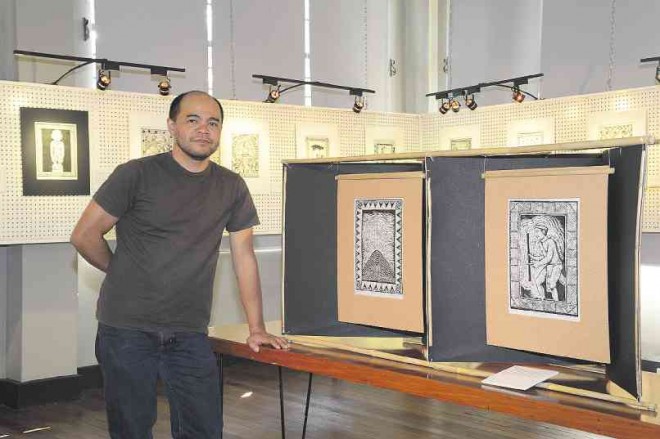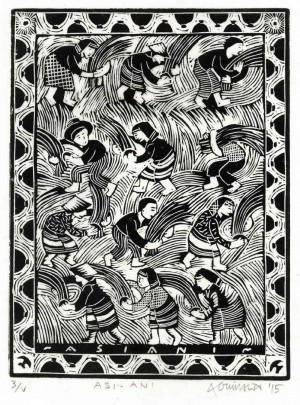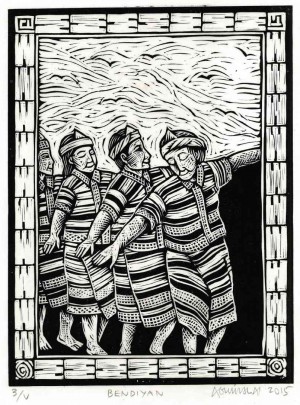iNima 2: A celebration of indigenous peoples’ culture

AGUINALDO presents his impressions of aspects of highland culture across the Cordillera. CONTRIBUTED PHOTOS
ARTIST LEONARD Aguinaldo has done 34 linocuts on Cordillera life and culture that draw from five indigenous traditions: Bontoc, Ibaloy, Ifugao, Isneg and Kalinga. His exhibit, “iNima 2,” at Maryknoll Ecological Sanctuary in Campo Sioco, Baguio City, runs until May 24.
This is his second show at the Sanctuary, his first being “Slash & Burn” 15 years ago. It is his 16th solo show in a career spanning almost two decades during which he has received national awards and citations.
His awards include the Thirteen Artists Award from the Cultural Center of the Philippines in 2003, the grand prize in the Asean Art Awards in Bangkok in 2004, Top Five Jurors’ Choice in the 2003 Philippines-Asean Art Awards and a Special Selection Award, Sea Art Festival, at the 2002 Busan Biennale, Korea.
The prints are part of a series of works representing his impressions of aspects of highland culture across the Cordillera. In a statement the artist described the creation of these images as a continuing process that he began 15 years earlier to document “the life ways of highland peoples, juxtaposed with the changes that technology and development have ushered in.”
The show’s title conveys both the link and contrast between “hi-tech” and “low-tech” (iNima being a wordplay which brings together its literal meaning from Ilocano of “by hand” or “handcrafted” and the modern idea or invention of communication iconized by the iPad and iPhone).
Aguinaldo said these images are the “inevitable result of (the artist’s) understanding and imagination—drawn from books, archival photographs, other printed materials and conversations with people from which these series of works have come to life.”
He added that the new works are “a continuation of a visual narrative that tells us of the bounty and beauty of the land, of a rich but simple life, of a story that give us a sense of what true heritage is all about in daily living.”
Exhibit curator Erlyn Ruth Alcantara wrote her insights on Aguinaldo’s art, with quotes from art critic Alice Guillermo’s essay on the artist. The notes underscore the significance of this in the context of Cordillera and Philippine ethnographic art:
“Aguinaldo’s training in architectural drafting at Baguio Colleges Foundation is put to good use in his art making. He says it was there where he developed the discipline that later afforded him the artistic confidence to produce expressive works of art. He has mastered the linocut medium and devised his own techniques that produce fine linear definitions, contrasts and textures that are best achieved in this kind of medium. The rich imagery in Aguinaldo’s works reflects the ‘intensity and coherence of his work.’ His use of indigenous iconography is nuanced by a profound sensitivity to the importance of honoring the integrity of cultures. This allows his audience to see the peoples’ life and work in a different light, away from the labels that come out of a fusion of invented representations with ‘ethnic,’ ‘primitive,’ or ‘ancient’ symbols where they become mere cultural curiosities and kitsch.”
The exhibit includes the triptych, “We Know What You Did Last Night.” The central object is the chainsaw, the universal symbol of exploiting the environment for corporate profit. This work refers to the controversial destruction of a stand of pine and alnus trees in Baguio to make way for a supermall’s multistory car park, a hot issue in the campaign agenda of Baguio’s community of environmentalists.
The artist wrote the captions for each linocut. Here’s a sample each from the five Cordillera groups represented:
Asi-appey (Bontoc): Men and women, including young boys and girls, are sent out to bless the rice fields. They put on their new, colorful wrap skirts, beads, loincloths and other clothes for the occasion. Each carries a wide-brimmed basket, luwa, for women and double baskets, khimata, for men. A back basket is an option.
Bendiyan (Ibaloy): This is the most festive dance performed by a community or a large number of persons. Following a leader, the men dance in a wide circle. Inside their circle, the women dance. Inside the women’s circle, the children dance. At the center are the gong players and a stump of a fern plant.
Mumbaki (Ifugao): The mumbaki, who performs religious rites, also passes on the knowledge of a clan’s genealogy. There were mumbaki in the past believed to have been able to provide genealogies for 10 generations which include descendants in both lines of certain important ancestors.
Taduk (Isneg): This is a courtship dance in which the girls and boys have specific roles to play. Only unmarried girls take part in dancing, with the same three or four girls repeatedly taking turns. Most boys and men, married as well as unmarried, are expected to join the circle.
Saggaypo(Kalinga): This is a set of bamboo instruments of different lengths, blown to produce a flute-like burst of sound. Several people play this with one saggaypo each, made to sound alternately to produce a good rhythm.
















